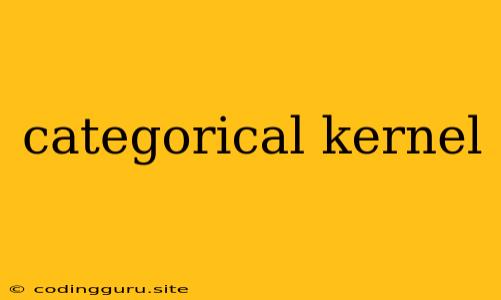Understanding Categorical Kernels: A Guide for Machine Learning Enthusiasts
Categorical data, data that falls into distinct categories, is ubiquitous in the real world. From customer demographics like gender, age, and location, to product features like color, size, and brand, categorical information plays a crucial role in shaping our understanding of the world. However, working with categorical data presents unique challenges in the realm of machine learning.
Traditional machine learning models, often designed for numerical data, struggle to directly handle categorical variables. This is where categorical kernels come into play. They offer a powerful solution by enabling us to effectively incorporate categorical features into kernel methods, a class of algorithms widely used in machine learning.
What are Categorical Kernels?
Imagine a scenario where you want to build a model that predicts customer churn based on their demographics. The information you have includes their age, gender, location, and income. You can't simply plug these categorical attributes into a standard kernel method like a Gaussian kernel.
Categorical kernels provide a way to encode categorical information into a suitable format for kernel methods. They essentially create a similarity measure between categorical features, allowing kernel methods to effectively capture relationships between categories.
Types of Categorical Kernels
Several types of categorical kernels exist, each tailored to different aspects of categorical data:
1. String Kernels:
- Purpose: String kernels are designed for textual data. They compare strings by identifying common substrings or patterns.
- Example: A string kernel could compare two customer reviews by looking for shared words or phrases, indicating a similarity in sentiment.
2. Hamming Kernels:
- Purpose: Hamming kernels focus on the number of differences between categorical variables.
- Example: For a product recommendation system, a Hamming kernel could compare the features of two products by counting the number of differing attributes, like color or size.
3. Fisher Kernels:
- Purpose: Fisher kernels leverage the statistical properties of a probabilistic model to define a kernel.
- Example: In a text classification task, a Fisher kernel could utilize a probabilistic model of language to measure the similarity between two documents based on their word distributions.
4. Tree Kernels:
- Purpose: Tree kernels are particularly useful for hierarchical categorical data.
- Example: For a hierarchical category like "clothing" (with subcategories like "shirts," "pants," "shoes," etc.), a tree kernel could measure the similarity between two items based on their shared position in the hierarchical structure.
Why Use Categorical Kernels?
Here's why categorical kernels are crucial in machine learning:
1. Enhanced Model Performance: By effectively incorporating categorical features, categorical kernels can significantly improve model accuracy and prediction quality.
2. Improved Interpretability: The structure of categorical kernels often provides insights into how different categories contribute to the overall similarity measure.
3. Handling High-Dimensional Data: Categorical kernels can handle large datasets with numerous categorical features, making them well-suited for real-world applications.
Examples of Categorical Kernels in Action
1. Recommendation System: A recommendation system could use categorical kernels to analyze user purchase history. By comparing the categories of items purchased by different users, the system can identify users with similar preferences and recommend items accordingly.
2. Text Classification: Categorical kernels can be applied to classify documents by analyzing the frequency of specific words or phrases. A string kernel, for example, could effectively capture semantic similarity between documents based on shared textual patterns.
3. Image Recognition: Categorical kernels can be used to compare images based on their features. For instance, a Hamming kernel could compare two images based on the presence or absence of specific object categories like "dog," "cat," or "bird."
Tips for Using Categorical Kernels
- Data Preprocessing: Before applying categorical kernels, it's essential to preprocess the data by cleaning, converting, and encoding categorical features.
- Kernel Selection: Carefully choose the categorical kernel that aligns with the characteristics of your data and the specific task at hand.
- Hyperparameter Tuning: Optimize the hyperparameters of the categorical kernel to maximize model performance.
- Interpretation: Analyze the results obtained using categorical kernels to gain insights into how different categories contribute to the model's predictions.
Conclusion
Categorical kernels offer a powerful tool for incorporating categorical data into kernel methods. By providing a way to measure similarity between categorical features, they significantly enhance the ability of kernel methods to learn from and make predictions based on categorical information. Understanding the different types of categorical kernels and their strengths allows you to leverage this technique in a wide range of machine learning applications, enabling you to extract valuable insights and build more accurate and effective models.
